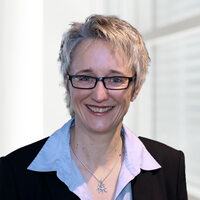Prof. Mayrhofer, would you let us in on the secret behind the formulas on the board?
We are currently dealing with tungsten carbide and tungsten nitride. The idea is to incorporate tungsten in a hard, firm layer. On contact with a sulfurous environment and high pressures, it develops a lubricant. Its effect would be comparable to that of molybdenum sulfide.
Essentially, you create materials that do not exist in that form in nature, right?
That’s right. Our objective is to develop materials with higher strength and greater toughness, but also improved thermal stability. Usually, however, these properties are mutually opposed. When you improve the hardness of a material, it is usually at the cost of lower toughness. And vice versa.
And what would be an example for a layman?
Gold is a soft metal, as we know, which can be deformed very easily. A knife made of gold would make no sense because it would be dull after the first cut. That doesn’t happen with a ceramic knife. However, the ceramic knife would break immediately if it fell to the ground. So we look for combinations utilizing the strengths of materials so that their drawbacks can be compensated.
Why did you choose a profession like this?
In my school in Burgenland, Austria, we took a career aptitude test in the 8th grade. It indicated that I should pursue a technical profession. A cousin of my mother was a shop teacher at the polytechnic school in the city of Eisenstadt. He was of the opinion that I should choose materials technology as my field of study. A number of teachers at the polytechnic school came from the university for metallurgy and mining in Leoben where I then studied materials science.
What’s so fascinating about materials science?
Without materials science, there wouldn’t be any technology. The development of mankind has always been linked to materials. There’s a good reason why entire epochs are named after them: Stone Age, Bronze Age, Iron Age, …
In what materials epoch are we living today?
As a materials scientist, I would have to say: in the Silicon Age. Silicon is a semiconductor, so we could also say the Semiconductor Age. However, for communications in the modern world, i. e. for smartphones, computers, laptops and so forth, you also need rare-earth metals. This is still a relatively unknown field.
Which materials are the special focus of your research?
A class of materials that I have dealt with throughout my career is that of the nitrides. They are the chemical compounds which result when nitrogen combines with metals. A compound with which my name is connected worldwide is titanium aluminum nitride.
Which materials might be of significance in the future?
What has been moving into focus more and more of late are the borides, or chemical compounds of boron with metals which display ceramic properties. They are even harder than nitrides, but, naturally, are also much more brittle.
Materials consisting of two elements, such as binary nitrides, carbides or borides, are considered to be well researched. What potential do materials consisting of three or more elements have?
We refer to these as ternary, quaternary or multinary compounds. These allow considerable improvements in material properties. At the same time, the complexity involved in the development of multinary systems like these is greater. Put differently: It takes much longer to thoroughly research and understand these compounds.
For example?
Titanium nitride is a common compound of two elements that has been in use now for a long time. The disadvantage: It forms a porous oxide layer. But if aluminum is added to the titanium and the nitrogen, the material properties change significantly. Aluminum also forms an oxide layer, however it is stable and dense. Titanium aluminum nitride is a material which develops higher strength when stressed through temperature or mechanically, making it especially suitable for drilling, cutting or milling tools.
If you combine all of the known elements, the possibilities are innumerable.
That’s right, the permutations result in millions of approaches. As a researcher, you are faced with questions your whole life long and it never stops, especially with coatings. The surface is always a complex matter because it is subject to so many influences. The physicist Wolfgang Pauli used to say, “God made the bulk; surfaces were invented by the devil.”
You have an INNOVA from Oerlikon Balzers in your lab. What do you use it for?
We use the INNOVA to ensure that our process development is as industry oriented as possible. The objective is resilient, stable coatings. As we do so, we work with fundamental aspects of research findings. What works. Where and how it works. What spectrum of possibilities exists. We also use complex computer simulations with which the properties of the coatings can be calculated at an atomic scale and thereby improved. Oerlikon Balzers specialists then refine our findings for customer applications.




































